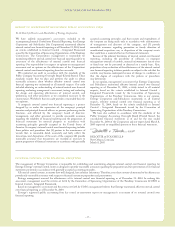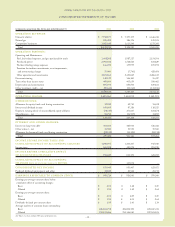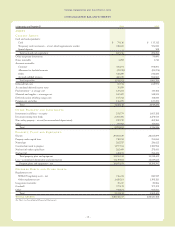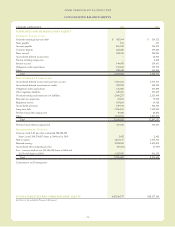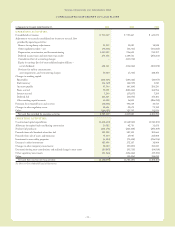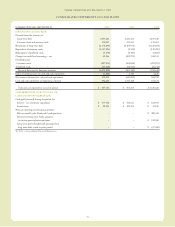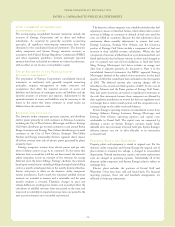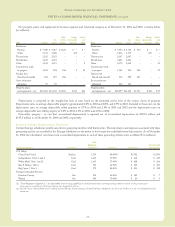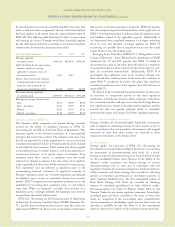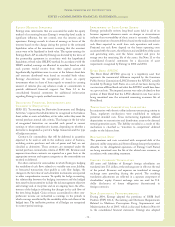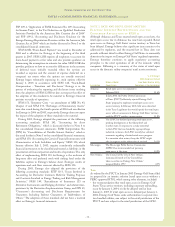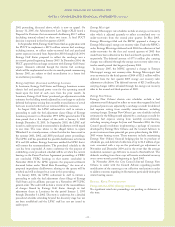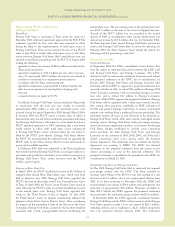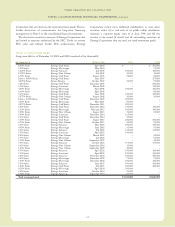Entergy 2004 Annual Report Download - page 59
Download and view the complete annual report
Please find page 59 of the 2004 Entergy annual report below. You can navigate through the pages in the report by either clicking on the pages listed below, or by using the keyword search tool below to find specific information within the annual report.
Entergy Corporation and Subsidiaries 2004
-57 -
the determination of net income for 2004 and 2003 is less than that
which would have been recognized if the fair value based method
had been applied to all awards since the original effective date of
SFAS 123. The following table illustrates the effect on net income
and earnings per share if Entergy would have historically applied
the fair value based method of accounting to stock-based employee
compensation (in thousands, except per share data):
For the years ended December 31, 2004 2003 2002
Earnings applicable
to common stock $909,524 $926,943 $599,360
Add back: Stock-based compensation
expense included in earnings
applicable to common stock, net
of related tax effects 5,141 2,818 –
Deduct: Total stock-based employee
compensation expense determined
under fair value method for all
awards, net of related tax effects 16,668 24,518 28,110
Pro forma earnings applicable
to common stock $897,997 $905,243 $571,250
Earnings per average common share:
Basic $4.01 $4.09 $2.69
Basic - pro forma $3.96 $3.99 $2.56
Diluted $3.93 $4.01 $2.64
Diluted - pro forma $3.88 $3.92 $2.51
Application of SFAS 71
The domestic utility companies and System Energy currently
account for the effects of regulation pursuant to SFAS 71,
“Accounting for the Effects of Certain Types of Regulation.” This
statement applies to the financial statements of a rate-regulated
enterprise that meets three criteria. The enterprise must have rates
that (i) areapproved by a body empowered to set rates that bind
customers (its regulator); (ii) are cost-based; and (iii) can be charged
to and collected from customers. These criteria may also be applied
to separable portions of a utility’s business, such as the generation or
transmission functions, or to specific classes of customers. If an
enterprise meets these criteria, it capitalizes costs that would
otherwise be charged to expense if the rate actions of its regulator
make it probable that those costs will be recovered in future revenue.
Such capitalized costs are reflected as regulatory assets in the
accompanying financial statements. Asignificant majority of
Entergy’s regulatory assets, net of related regulatory and deferred
tax liabilities, earn a return on investment during their recovery
periods. SFAS 71 requires that rate-regulated enterprises assess the
probability of recovering their regulatory assets at each balance
sheet date. When an enterprise concludes that recovery of a
regulatoryasset is no longer probable, the regulatory asset must be
removed from the entity’s balance sheet.
SFAS 101, “Accounting for the Discontinuation of Application
of Financial Accounting Standards Board (FASB) Statement No.
71,” specifies how an enterprise that ceases to meet the criteria for
application of SFAS 71 for all or part of its operations should report
that event in its financial statements. In general, SFAS 101 requires
that the enterprise report the discontinuation of the application of
SFAS 71 by eliminating from its balance sheet all regulatory assets
and liabilities related to the applicable segment. Additionally, if
it is determined that a regulated enterprise is no longer recovering
all of its costs and therefore no longer qualifies for SFAS 71
accounting, it is possible that an impairment may exist that could
require further write-offs of plant assets.
Emerging Issues Task Force (EITF) 97-4: “Deregulation of the
Pricing of Electricity - Issues Related to the Application of FASB
Statements No. 71 and 101” specifies that SFAS 71 should be
discontinued at a date no later than when the effects of a transition
to competition plan for all or a portion of the entity subject to such
plan arereasonably determinable. Additionally, EITF 97-4
promulgates that regulatory assets to be recovered through cash
flows derived from another portion of the entity that continues to
apply SFAS 71 should not be written off; rather, they should be
considered regulatory assets of the segment that will continue to
apply SFAS 71.
See Note 2 to the consolidated financial statements for discussion
of transition to competition activity in the retail regulatory
jurisdictions served by the domestic utility companies. Only Texas
has a currentlyenacted retail open access law, but Entergybelieves
that significant issues remain to be addressed by regulators, and the
enacted law does not provide sufficient detail to reasonably
determine the impact onEntergy Gulf States’ regulated operations.
Cash and Cash Equivalents
Entergy considers all unrestricted highly liquid debt instruments
with an original or remaining maturityof three months or less at
date of purchase to be cash equivalents. Investments with original
maturities of more than three months are classified as other
temporary investments on the balance sheet.
Investments
Entergy applies the provisions of SFAS 115, “Accounting for
Investments for Certain Debt and Equity Securities,” in accounting
for investments in decommissioning trust funds. As a result,
Entergy records the decommissioning trust funds at their fair value
onthe consolidated balance sheet. Because of the ability of the
domestic utility companies and System Energy to recover
decommissioning costs in rates and in accordance with the
regulatory treatment for decommissioning trust funds, the domestic
utilitycompanies and System Energyhaverecorded an offsetting
amount of unrealized gains/(losses) oninvestment securities in
other regulatoryliabilities/assets. For the nonregulated portion of
River Bend, Entergy Gulf States has recorded an offsetting
amount of unrealized gains/(losses) in other deferred credits.
Decommissioning trust funds for Pilgrim, Indian Point 2, and
Vermont Yankee do not receive regulatory treatment. Accordingly,
unrealized gains and losses recorded on the assets in these trust
funds are recognized in the accumulated other comprehensive
income component of shareholders’ equity because these assets are
classified as available for sale. See Note 15 to the consolidated
financial statements for details onthe decommissioning trust funds.
NOTES to CONSOLIDATED FINANCIAL STATEMENTS continued


